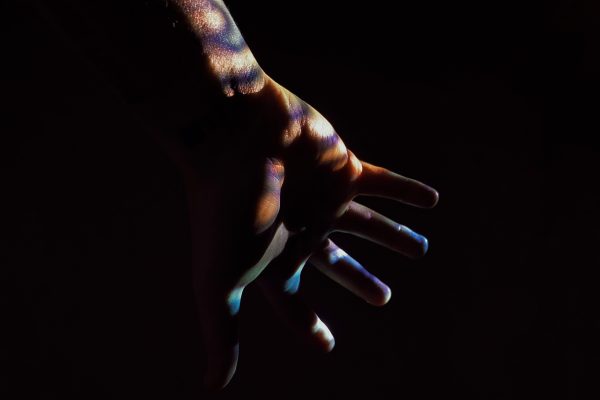Video content in this article was produced with support from Canadian Heritage through the Business Innovation component of the Canadian Periodical Fund.
With MOI — Momentum of Isolation, choreographer Shay Kuebler aims to distill and examine loneliness. The newest work from Radical System Art, the show was first conceived by Kuebler in 2018, two years before the pandemic lockdowns began and isolation became the norm. Now on a national tour, the show premiered in Halifax on Oct. 21 at Spatz Theatre, presented by Live Art Dance.
Emily Pettet, The Dance Current’s marketing and development director, went backstage to speak with artists hours before their first Halifax show. Below, Kuebler speaks to the challenges of taking this show on a national tour — with a complex production element, including puppets — and the its resonance with a post-COVID audience.
The tour will finish with two shows in Edmonton on Dec. 16-17 at the Timms Centre for The Arts.
***
Emily Pettet: How would you describe this work to someone who’s never heard of it before?
Shay Kuebler: So Momentum of Isolation is a dance-theatre piece. I mean, the bridge between dance and theatre is obviously sometimes very close; they live in the same space. But the show originally started in 2018. It is about isolation and loneliness. So it’s a show that explores ideas and topics on isolation that are caused by technology, society, ever-shifting values. And the dance and theatre kind of combine together to make a performance that’s really physical and really dynamic, but also, it’s always referring back to the story in terms of what’s happening with the characters within it.
EP: Tell me about what’s happening tonight.
SK: We are in our very first show on tour here – we’re doing a national tour of Momentum of Isolation. We are about four hours away from the show. We had a bit of a delay with a lot of our equipment and technical gear, so we’re about a day behind our prep and setup. But we’re essentially finishing all our lighting cues while at the same time trying to stage and rehearse, so we’re kind of multitasking as best we can. It’s the nature of touring. And we went from the furthest point in Canada, almost; we went from Vancouver to Halifax. It’s a big journey. So we’re trying to get caught up but we’re close. We’re four hours away, so showtime is very soon.
EP: Tell me about the challenges you faced in putting on a show like this.
SK: This was an interesting work for me because, in some ways, the time that we had to make this work was extended because of the pandemic. I didn’t realize that I was going to be making a work that would become more resonant and more relevant because a work around isolation and loneliness obviously became more relevant for a lot of people with the pandemic. So I felt fortunate that I was able to still keep working on the work through that time and the time that we’re still kind of on the fringes of.
For me, the process felt like a really critical and important topic to talk about when I first started researching it, and then when I got into the rehearsal process, I just found there was this huge world, this huge scope to the work that I had to articulate. So it felt monumental in some ways because I was like, ‘I could make a two-hour piece,’ and I obviously didn’t want to do that. So the process of editing was really important and also, I think, distilling down what was the most valuable scenes to show.
It’s the first show where we’ve incorporated, kind of, puppets, in some ways, which also felt really critical to talk about. One of the big elements of isolation is that people who become isolated or who have been isolated for a long time, they start to create relationships sometimes with inanimate things, or they try to build social connections with things that are in their space. So it became a really interesting parallel between these production elements and how important they were to the storyline. That was something that became a challenge but also really exciting to work with. I think, overall, it was challenging because I felt like I had so much that I wanted to say. And just trying to find the right way to kind of bring all of the scenes and elements together was probably one of the hardest things.
EP: What do you hope audiences take away from MOI?
SK: I’ve always wished for my dance works to have this theatre element where hopefully the dance and the physical performances can connect to an audience more, that we’re not just living in the virtuosity and the technique of dance but that it’s expressing these emotional processes, these emotional things that we’re going through. So I hope that, first of all, the show reaches people on that front, that they feel the emotional weight and the gravity to the show and also its topic. This show, to me, is probably one of the most important shows I’ve made because, it’s not really talked about all the time, but isolation and loneliness are these two, kind of, modern diseases that are continuing to increase in prominence. It’s really becoming even more and more relevant for younger generations. Cases of anxiety, depression, suicide, these are numbers that are all coming up, and there’s a lot of studies showing that this is related to social isolation, a sense of loneliness, a sense of lack of connectedness, lack of community. So it feels like a really important show. I’d love to keep it going. I’d love to give this show as much life as I can because I do feel like its message is really valuable.
This conversation has been edited for clarity.
Give a gift, get a gift! Send a loved one a gift subscription to The Dance Current this holiday season and you’ll received a FREE tote bag! Offer ends December 11.







